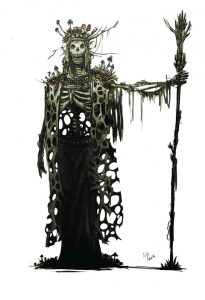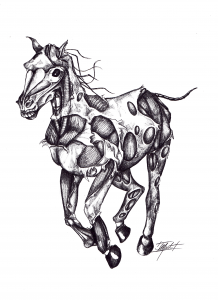So I’ve played a lot of World of Darkness over the years; and I love the setting. That’s oWoD for the afficionadoes, but for most of that time it was just WoD. The system, however, leaves a lot to be desired. I had a decent idea for a campaign. So I bodged together a version of FATE, for which I do like the system. I’ve been running weekly since October, and have obtained my players permission to use their characters to explain how I went about such a mashup.
What does the old system have that I don’t like?.
WOD relies on buckets of dice and a long skill list. But it can be problematic to model advancement – learn a new skill and suddenly you’re actually worse than not bothering. Plus there’s the whole ‘more dice = more chances to botch’
Combat is basically down to number of moves – if you don’t have Rage or Celerity, and your opponent does, you almost always lose. Oh and death spiral is a thing some people like and I don’t. Hollywood heros fight on with feet full of glass and a bullet in the shoulder – why shouldn’t mine!
What does the new system have that I like?
Aspects. I love the descriptive part “Son of a Gun” “I Got A Plan for That” or even “Too Good at Being Bad”. High Concept and Trouble stay as usual (See FATE Core), and two personal aspects customise; but a second trouble adds the Clan Flaw in a new way.
In this game I have three Brujah. VTM gives the all Bru a +2 to frenzy difficulty. For my game we got three different takes on the clan of rebels and revolutionaries – the Punk, the Pirate, and the Paladin.
Doc is a Rebel With A Clue by Four. He likes to fight, particularly against oppressive authority figures (one of his personal aspects is Bash the Fash) His Clan Flaw is expressed as Sees the Oppression – he can’t help himself, siding with the underdog.
Carabo is a Somali Pirate. She used to captain her own ship – until she was turned. But even in death she hasn’t quite managed to shed the stigma of being both black and female (and also Illiterate) she’s Frustrated by Inequality
Robert is an Ex Military Policeman. Taken by the Brujah for standing up to one of them, he’s not so much a footsoldier in the Jyhad as a reluctant officer. His Clan Flaw is Shield of the Vulnerable – taking the police motto ‘Serve and Protect’ to another level.
I decided on six aspects over the usual five, because I wanted to include something I learned from a one off – the Hook. So at the end of chr gen you ask – how do characters know each other? So you get family (Eve is Lucian’s ward; Assistant Lasombra) affiliates (Rob is Doc’s clanmate; Brother in the Cause) and even rivalry (William doesn’t like Carabo; Keep your Friends Close)
What does the origInal do that I want to keep / need to remodel?
The Humanity / Beast / Path & Virtues system. Being wicked should have a cost – the whole “Beast I am lest Beast I become” thing.
It comes down to ‘how much in control am I’ and so I chose to model it like damage. Hungry or angry – the Beast gaining control is modelled by the Beast Track. Our Ventrue couldn’t find her favored food, and was subsisting on the bread-and-water diet of blood bags. She could still animate herself, but she suffered the Consequence of “Perpetual Hunger” until she finally managed to find a blood source she could utilize for her Disciplines. Turned out another party member suited; she had the angst of ‘drink now and retain some control, or keep looking and risk draining him dry’.
Disciplines and Backgrounds through Stunts
Why are some people chosen for the Embrace and some passed by? Mortal Stunts. Lucien is a CEO and is Wealthy; +2 to any skill check where he can directly bring wealth to bear (remember Wheaton’s Law here) On the other hand, Doc is expert at making do, and can Jerry Rig; for a Fate point, use Crafts without proper tool or parts
The vampires Cool Magic Powers – turning into bats, mesmerising prey and hiding in plain sight – become more interesting when modelled through Stunts. I decide that there is no real reason why one needs to preserve the hierarchy of powers presented in VTM and instead went with basic, intermediate and advanced. Party members could only have basic level at start. But the Lasombra and the Ventrue took a Dominate power – but flavored differently
Eve is a Victorian young lady. Her power is an immediate response, for a Fate Point “Stop. Lie down. Freeze” described as Though She Be But Little, She Is Fierce
Lucian’s use is more subtle – “wouldn’t now be a good time for a teabreak?” Mind over Matter still costs a Fate point (we rejected These Aren’t the Droids). He’s since picked up Master of the Manor which duplicates Eve’s power
Robert and William’s powers diverge from classical Celerity. Robert has Take a Bullet – interpose himself to take an attack for someone else. William, as a Toreador thief, has Hand is Quicker than the Eye, allowing him to use his supernatural speed to avoid notice.
Experimentation showed that it’s massively easier to make all the Discipline Stunts work off Fate points, freeing you from the need to track blood exactly.
Neither does this system thing great, so which is easier to integrate?
Skills stayed pretty unchanged from Fate Core, except for splitting Knowledge into mundane Knowledge and Arcane (all kinds of supernatural). Oh and we renamed Larceny to Nefarius; and it now covers all kinds of crime; from theft to jumping trams without a ticket to credit card fraud. Will becomes much more key as it not only is it the key roll to power and resist Dominate, but is need to resit Beast Damage.
Combat is a weak point for Fate, but it is mitigated by the ability to create Advantages, meaning it is actually worth it to set ambushes, taunt opponents or discover weaknesses.
So there you have it. It might sound pretty clunky, but it works. And my players nearly all came back for Season 2, and Season 3, and were bugging me for a Season 4.







